Our Verdict
Taking lessons learned from previous games, trimming out anything less effective, and scoring home runs with its fresh additions, Like a Dragon: Pirate Yakuza in Hawaii is the new gold standard for the series and an absolute treat for RPG and action game fans.
Last year’s Like a Dragon: Infinite Wealth was a monumental RPG that effectively closed the series-spanning arc of legacy protagonist Kazuma Kiryu and stepped into the next chapter of Ichiban Kasuga’s. It wasn’t immediately clear where Ryu Ga Gotoku Studio could go next, and the reveal of a pirate-themed spinoff likely wasn’t anyone’s first guess. Like a Dragon: Pirate Yakuza in Hawaii is a direct sequel to Infinite Wealth that sends longtime series favorite Goro Majima on the series’ wackiest adventure yet, taking him across the high seas, back to his action-brawler roots, and ending up as the best in the studio’s brawler lineup.
Pirate Yakuza sees Majima trek to Honolulu, Rich Island, Nele Island, and Madlantis. With the Mad Dog mysteriously struck with severe amnesia, the story doesn’t seek to rebuild his character from the ground up but instead focuses on what innately remains in his moral code and personality. The mainline narrative digs into the remnants of Infinite Wealth’s cult of Palekana, the directionless yakuza sent to Nele Island, and the enigmatic Lost Treasure of Esperanza. It’s a winding plot with all the twists you’d expect from Like a Dragon, but it also offers some proper introspection into Majima’s character. It’s not nearly as huge in scale as Infinite Wealth, but it’s not trying to be, and its reduced scope helps its effective storytelling and character writing.
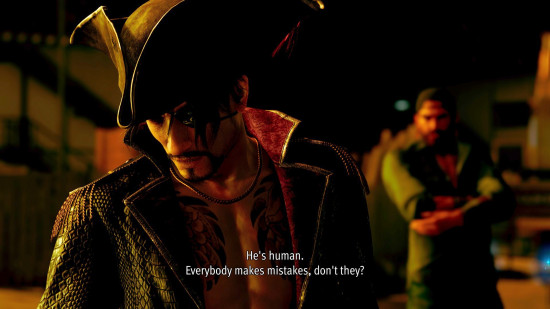
Besides Majima, the faces you’ll see most are the father and son duo of the Rich family – Noah, a child full of wonder begging to see the world, and Jason, his troubled father who nevertheless wants the best for his son and those around him. They’re joined by ship bodyguard Fujita and ex-Tojo Clan captain Shigaki, both charming side characters whose motives remain tantalizingly unclear for a time.
The new cast makes a fantastic impression, with special mention going to the endearing shadiness of Shigaki. But it’s not all fresh faces. Majima’s closest aides, including his sworn brother Saejima and subordinates Nishida and Minami, are more than cameo characters here, which forces him to confront his past and present. All of these threads coalesce to make Pirate Yakuza in Hawaii a swashbuckling and touching tale of forgiveness, fatherhood, and freedom.
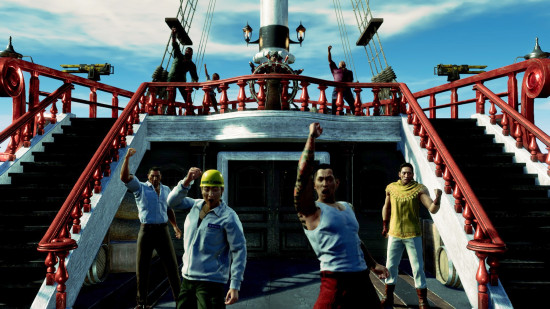
Given its return to the series’ classic brawler action, I wasn’t sure if Majima’s combat could match the peaks of his playable appearance in Yakuza 0. Thankfully, my concerns quickly melted away upon getting to grips with his two new styles. Majima’s innate style, Mad Dog, combines and streamlines his previous Thug and Mad Dog of Shimano styles into one ultimate moveset that is without question the best he has ever felt to play. Taking the rapid punches, kicks, and choke-outs of Thug alongside the frenzied slashes and dashes of his previous Mad Dog moves, this style turns everything that worked in Yakuza 0 up to eleven, letting Majima gracefully slice enemies to ribbons.
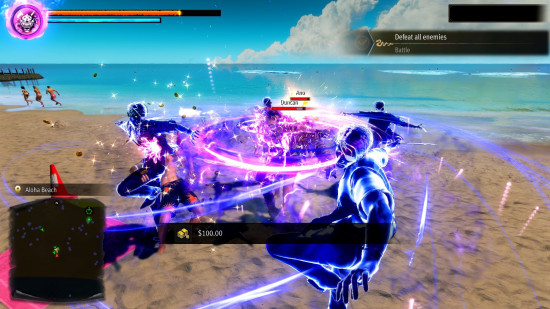
With a snappy style switch and outfit change, Majima can use his second and all-new style: Sea Dog. Befitting its pirate theme, Sea Dog grants Majima a pair of cutlasses that you can throw as lethal boomerangs, a flintlock pistol to control space and blow enemies away, and even a grappling hook that sends him flying toward an impaled target. While Mad Dog excels at cutting down single enemies, Sea Dog can effortlessly crowd-control massive groups when played correctly. Unlike the gadgets of Like a Dragon: Gaiden’s Agent style, which were fun to use but felt disconnected from one another and Kiryu’s regular attacks, this buccaneer’s arsenal flows harmoniously. On that note, canceling attacks into quicksteps and switching styles on the fly ensures you can keep the action moving.
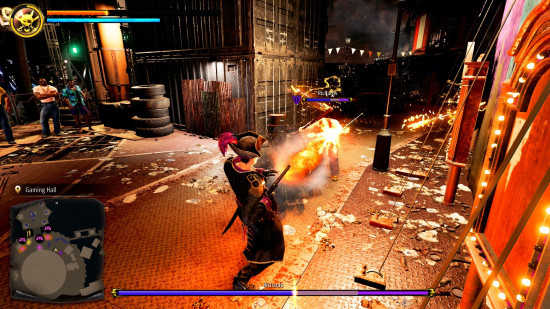
Pirate Yakuza in Hawaii’s biggest combat additions include the new jump button and the Madness Gauge. The former allows Majima to leap into the air at will, following up with a wide aerial dodge, a helm breaker smash back to the ground, or a volley of diagonal knife tosses. However, you’re most likely to jump after using one of his several launchers, sending foes flying into the skies for a Devil May Cry-esque air juggle. While a jump button may sound like a simple addition, it can’t be overstated how much it changes Like a Dragon’s combat loop. Fans of Gaiden and Lost Judgment will be glad to hear that legacy manual juggling also remains intact.
With a full Madness Gauge, which is separate from the returning Heat Gauge, Majima can unleash two style-specific abilities to turn the tide of any fight. With Mad Dog active, a Madness activation summons several shadowy doppelgangers that either follow Majima’s moves or act independently depending on your actions. Longtime players will remember the fear this attack instilled when we were on the receiving end.
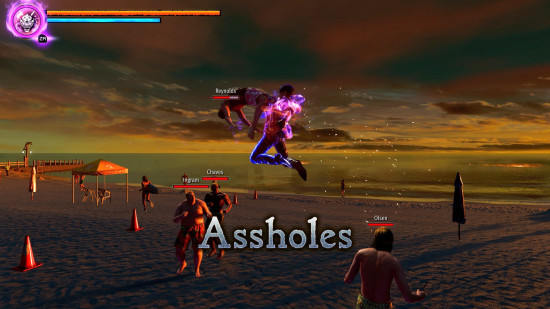
Contrastingly, Sea Dog’s Madness activation sees Majima play a melody on one of four Dark Instruments. You can find these as treasures when exploring, and they each summon eldritch monsters from the depths to rip crowds apart. A violin that brings forth a horde of great whites may sound ridiculous, but it somehow works.
Noah’s adorable tiger cub Goro also assists Majima in fights. The game runs like a dream through all this chaos even with the consistent luster of the Dragon Engine’s real-time rendering. Putting all these elements together, this is the best combat system of all the Dragon Engine brawler games, even with the tough competition of Lost Judgment and Gaiden.
Pirate Yakuza also includes some well-considered accessibility options for those who want to customize the experience. The ‘action assist’ simplifies complex combos, and the ability to automatically pass quick-time events allows you to sit back and enjoy mid-fight cutscenes without fretting over surprise QTEs.
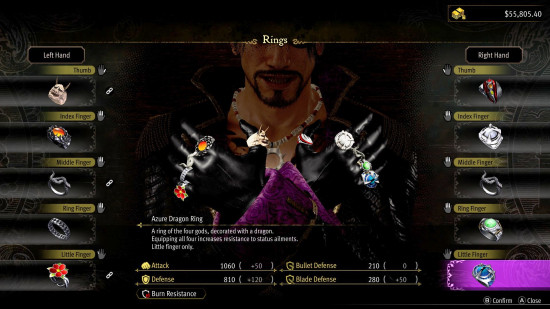
Majima gradually becomes a terrifying force on the battlefield, with upgrade trees boosting his base stats, new Heat Actions widening his arsenal, and the Mad Dog’s Perfect Quickstep rewarding well-timed dodges with an exhilarating boost in combo speed. These upgrades are unlocked through a combination of spending money and points gained by raising the Goro Pirates’ rank by completing challenges related to story missions, side content, and combat.
You can also augment Majima’s strengths by equipping a variety of Rings, an evolution of the classic gear system. Often found in treasure chests, these go one step further than usual gear by offering expected boosts and set bonuses tied to wearing specific rings together. For example, completing the Four Gods set gives Majima a resistance to all status ailments, while the Hannya set increases Mad Dog’s attack speed. This encourages you to seek out any missing pieces from a set and adds extra depth to the series’ gear system.
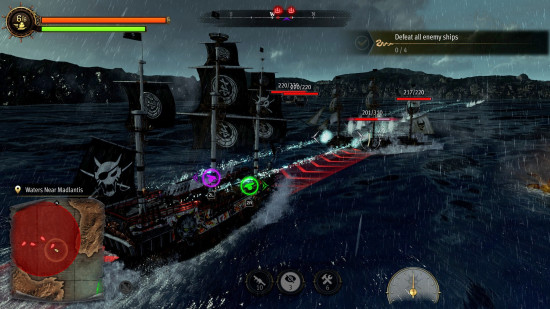
As for where you’ll find these treasures, it’s time to talk about the pirate ship. As the Goromaru sails across the Hawaiian waves, your voyage occasionally brightened by sea life and shanties from your crew or darkened by tropical storms, the addition of naval traversal and warfare proves to be well designed and executed. Piloting the ship is appropriately weighty without feeling cumbersome, allowing for satisfying free movement while forcing you to consider your turns carefully. The cannons, machine gun, and on-deck rocket launcher all encourage you to position yourself carefully in relation to your enemies to maximize your damage output and minimize theirs. Upon sinking the main ship of a fleet, Majima and his crew leap aboard to plunder it personally, kicking off a huge-scale fight. The ebb and flow of sailing and naval combat never gets old, and only grows more engaging as you face tougher crews.
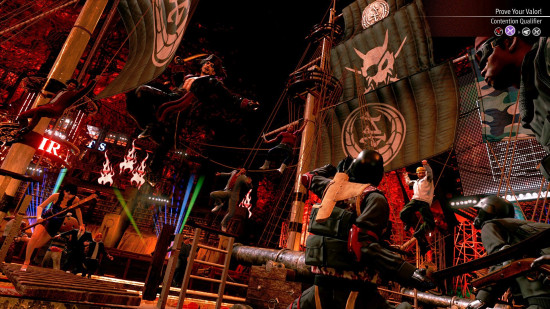
The hardest foes arrive in the game’s side story and the quest to take down Hawaii’s dreaded Devil Flags. These crews offer a genuine challenge for those willing to invest in the naval side story and take the Goro Pirates to dungeon-like islands full of treasure and treachery. There’s also the Pirate’s Coliseum in Madlantis, which puts the Goromaru through a gauntlet of naval battles and deck brawls. With new islets opening up as you complete more of the side story, a wealth of upgrades, customization options, and crew members to acquire, and a dragon horde’s worth of treasure to find, there’s enough here for an entire naval campaign in this side story alone.
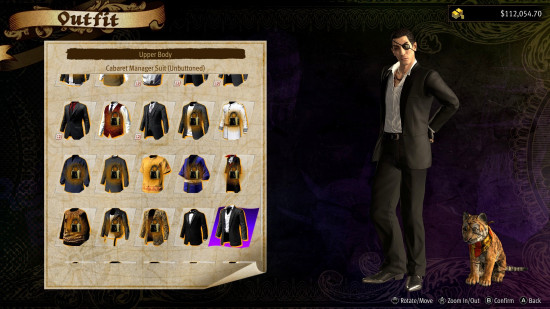
Beyond the high seas, the returning Honolulu and the new Rich and Nele islands are beautiful, filled with friends to add on Aloha Links. Scattered around are bounties (particularly difficult fights granting money and points) and treasure chests tucked away on roofs and balconies, which you can scale using Majima’s grappling hook. In addition to treasure chests, you can also find containers housing valuable items like outfit pieces. There’s a full customization system featuring outfits from Majima’s past such as his Yakuza 0 cabaret manager suit or his Goromi drag persona, as well as a variety of trendy and garish clothes to deck out this now 60-year-old man.
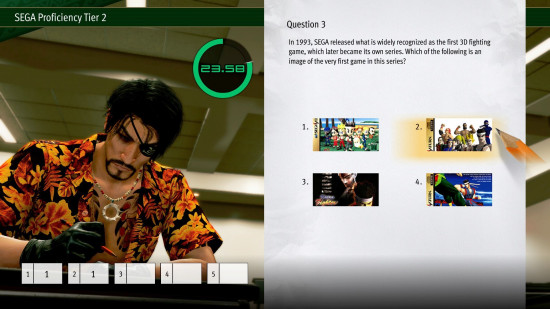
With this being a Like a Dragon game, there is also a gargantuan amount of side content, substories, and minigames on offer. Series staples like karaoke, pool, darts, and mahjong all return as expected, alongside more recent additions like the copyright-free racer Dragon Kart, the high-speed, low-pay Crazy Delivery, and the brain-teasing Vocational School exams. The arcade offerings are also impressive, featuring fully playable versions of Virtua Fighter 3, Fighting Vipers 2, and Spikeout. Madlantis even has a literally explosive remix of the classic batting center minigame, befitting the area’s dangerous vibe.
Substories wonderfully toe the line between touching and off-the-wall, with several taking note of Majima’s amnesia for unique setups and payoffs. There’s a solid mix of new characters and stories alongside continuations of quests from Infinite Wealth, so newcomers to Hawaii won’t be too lost, while veterans of Kasuga’s adventure will find their knowledge rewarded. Party chats and drink links also return, granting meaningful insight into the outlooks, vulnerabilities, and dreams of Majima and his loved ones as they spill their souls and clink their glasses.

Hidenari Ugaki delivers an incredible performance as Majima that’s on par with his much-celebrated turn in Yakuza 0. From the enthusiastic high register of his cackles and jokes with his crew to the powerful and sometimes terrifying baritone reserved for earnest conversations and convincing threats, his performance perfectly captures Majima’s nuance and complexity. Other standouts include First Summer Uika’s Noah and Munetaka Aoki’s Shigaki. The former sidesteps the ‘annoying child character’ curse while remaining lovable, and the latter is a shining example of the kind of carefully developed and sympathetic antagonist performance the series is known for.
While it almost goes without saying that a Like a Dragon game has a strong soundtrack, Pirate Yakuza in Hawaii knocks it out of the park with its hybrid of crushing rock and metal with high-tempo techno. Special mention goes to three tracks: the Mad Dog battle theme, a low and aggressive track that appropriately calls to mind Yakuza 0’s One-Eyed Assassin; Saejma’s theme, a fantastic remix of Yakuza 4’s adrenaline-pumping battle track Massive Fire; and one long battle theme towards the end of the game that beautifully ties together several of Majima’s previous themes into a treat for the ears.
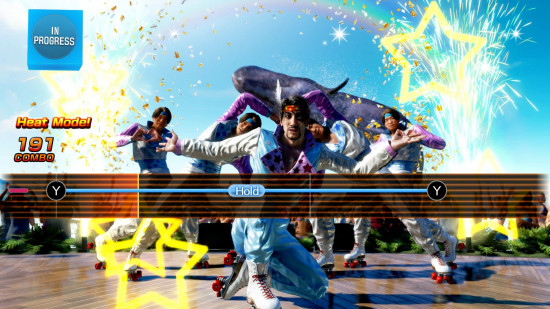
Alongside the return of Majima’s earlier karaoke songs, Pirate Yakuza in Hawaii adds four new tracks to the Mad Dog’s discography. The Goro Pirates’ Theme and Song of Departure bravely ask ‘What if the Like a Dragon music team composed rock sea shanties?’ to wonderful results. As for Majima’s solo performances, The Sun at 36.5c is a jovial and heartfelt pop ballad harshly contrasted by Midnight Desire, a thrash metal track musing on twilight junk food cravings.
Like a Dragon: Pirate Yakuza in Hawaii is what happens when Ryu Ga Gotoku Studio fires on all cylinders, iterating on previous successes and failures to create its most satisfying and airtight game in years. Every aspect feels deliberate, with no feature bloat to speak of even in a sprawling RPG with so many moving parts. As a love letter to Goro Majima and an all-around fantastic action game, Like a Dragon: Pirate Yakuza in Hawaii is a treasure that shouldn’t be missed.
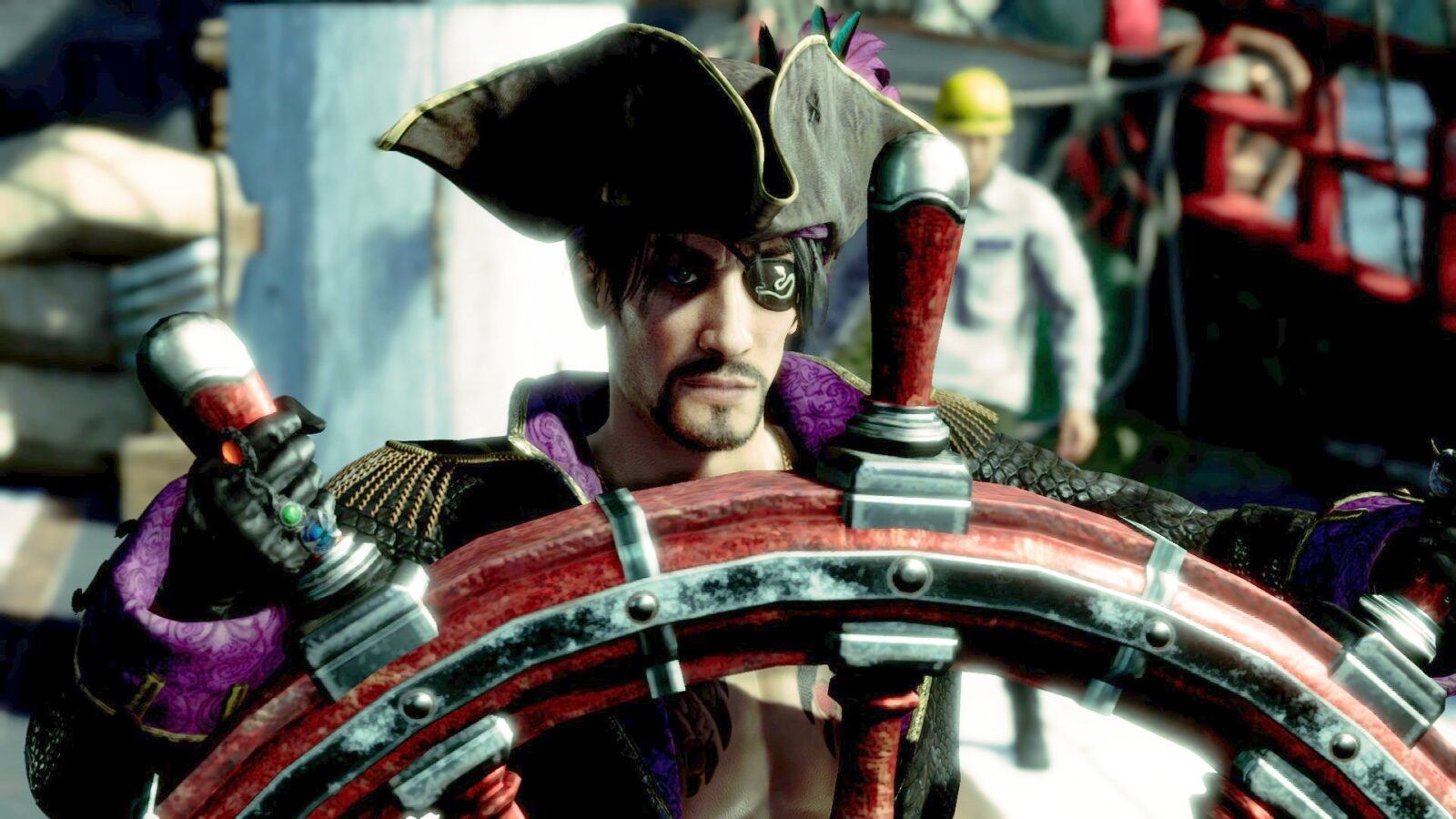









Leave a Reply